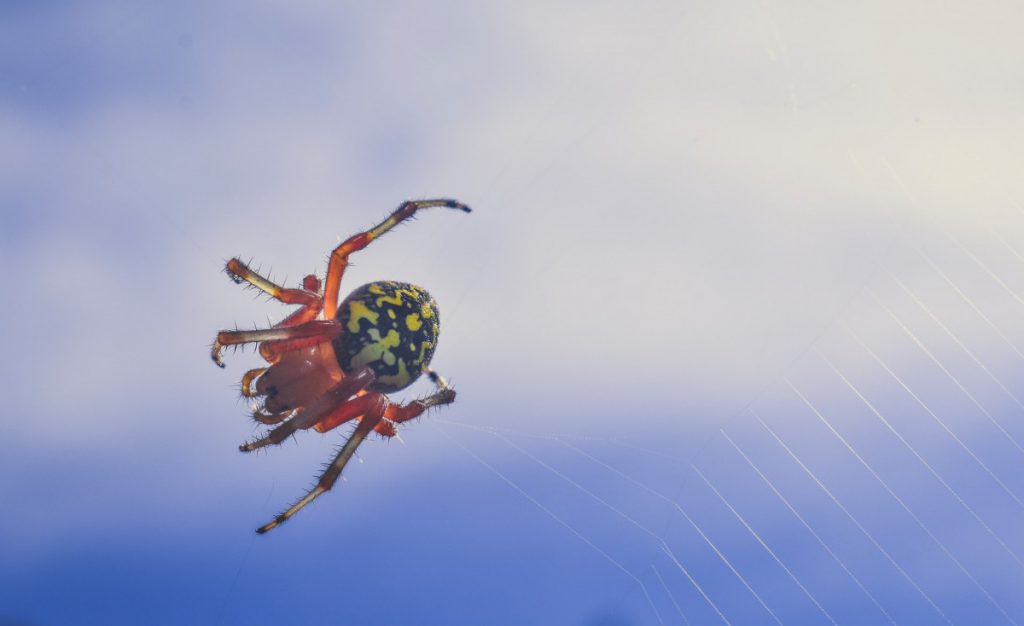
Spiders are the largest order of joint-legged invertebrate animals in the class Arachnida. There are more than 30,000 known species of spiders, possibly as many as 100,000 species exist worldwide.
Most of them tend to be drab in appearance, with black, brown or grey colors, including many members of some of the most venomous species such as Black Widows, Brown Recluses and Wolf Spiders.
However, colorful spiders are not uncommon – there are a few hundred species of red, green, yellow, blue and even pink colored spiders found in nature.
Spider colors arise from three sources:
- (a) natural pigmentation,
- (b) structural colors
- (c) colors generated due to guanin deposits on their skin
Many colors come from actual pigments in a spider’s scales – brown and yellow shades come from melanin, the same pigment we humans have. On the other hand, spiders can show bright blue, green, red, pink or purple coloration on their bodies, legs or chelicerae due to structural colors created by photonic cells reflecting certain bands of light.
Natural pigmentation stays the same whenever or wherever you see it. But with structural colors, the angle at which light hits the wings as they flutter will cause the color to change – a shimmering effect we call iridescence.
Finally, some spiders build up significant deposits of guanine on their scales. As a result, they reflect all sunlight and appear pearly white or silvery in color.
We start with the most common colors of spider below, before going on to the more exotic varieties.
Can Spiders Be Brown?
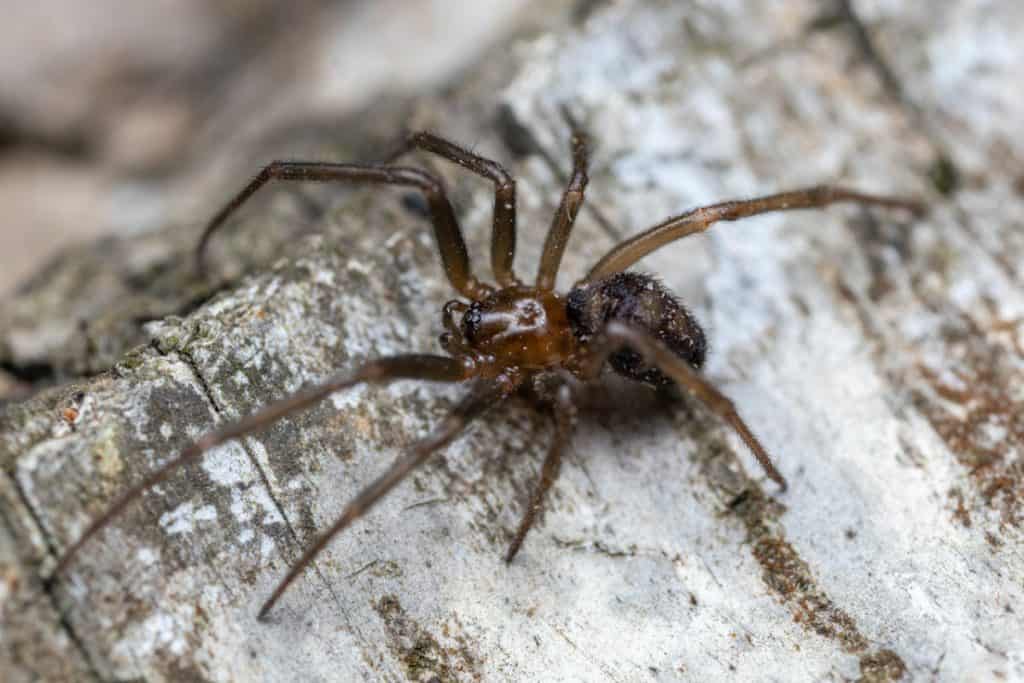
Brown or tan are common colors among spiders, including some of its most venomous and aggressive species such as the Brown Recluse, Wolf Spiders, Hobo Spiders and Mouse Spiders.
a) Are Brown Spiders Rare?
Brown spider species are extremely common. The deadliest spider found in North America is the Brown Recluse (Loxosceles reclusa). Their venomous bite can cause significant damage to subcutaneous tissue, leading to necrosis.
Recluse spiders are not always aggressive but will bite if threatened. Adult Wolf Spiders are also venomous, but not lethal to humans. The ones found in the US are mottled gray to brown in color and between 1 inches to 2 inch in body length – the North Carolina Wolf Spider (Hogna carolensis) is the largest.
Australian Wolf Spiders tend to be larger than their American cousins. Hobo Spiders (Tegenaria agrestis) pack a venomous punch in their small (less than 1 inch) bodies. The Mouse Spider (Scotophaeus Blackwalli) has a brown body and bright red head.
Finally, there are many brown or tan colored tarantulas found over the world. For example, the Texas Brown Tarantula (Aphonopelma hentzi) is a large, dark brown spider common to the Southern United States.
b) How Do You Identify Brown Spiders?
Ranging in size from ¼ inches to 1 inches, the Brown Recluse Spiders are characterized by a dark violin shape at the top of its leg attachment, with the neck pointing towards the abdomen.
They also have six eyes instead of the normal 8 found among spiders. The Brown Violin Spider has its own distinctive violin mark on its combined head and midsection. Though the Wolf Spider is sometimes mistaken for a Brown Recluse, they are distinctly different – larger in size, with 8 striking eyes arranged in three tiers and spines on its legs.
The North Carolina Wolf Spider has a distinctive Union Jack impression on its back. Hobo Spiders have brown bodies and yellow markings on their abdomens. Mouse spiders have bright red heads. Tarantulas can be identified by their hairy legs and bodies – they are typically not harmful to humans despite their scary appearance.
c) Where Can They Be Found?
Brown spiders are found on every continent. Brown Recluses are found in a broad belt across the entire breadth of the US. The Brown Violin Spider is found in Hawaii. Wolf Spiders abound in Australia and the US, as do Mouse Spiders. Hobo Spiders are primarily found in the Pacific Northwest in North America. Brown tarantulas are common all over the world.
Can Spiders Be Black?
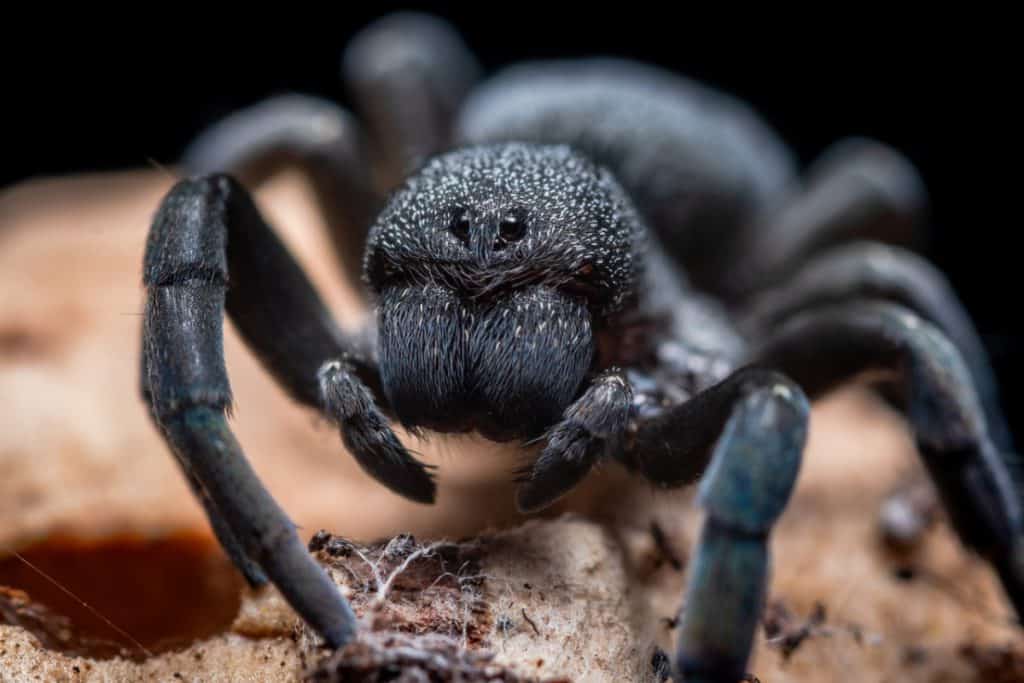
Black spiders often invoke fear, due to the name association with the deadly Black Widow spiders – so named due to the female of the species eating their partners after mating. There are however thousands of species of black colored spiders found all over the world.
a) Are Black Spiders Rare?
Black is a common color among spiders. The Black House Spider (Badumna insignis) is a dark robust spider found everywhere. There are some 4000 species of Black Jumping Spiders (Phiddippus audax being a common one) found worldwide. There are also a bevy of black tarantulas, including the recently named Aphonopelma johnnycashi, named after the famous Man in Black, Mr. Johnny Cash.
The species to watch out for is the deadly Black Widow Spider. In the US, there are multiple types of Black Widows – including the Southern Black Widow (Latrodectus mactans), Northern Black Widow (Latrodectus hesperus) and Western Black Widow (Latrodectus variolus).
The Black Widow’s bite is extremely toxic – luckily, an excellent antivenin exists, but you must be alert enough to recognize the symptoms and seek medical attention.
b) How Do You Identify Black Spiders?
While the black color is not necessarily distinctive, it’s important to be able to spot black spiders that are venomous and harmful to humans. In particular, look for the Southern Black Widow.
The male is about � inches across. The female is larger, shiny black with a yellowish orange/red hourglass shaped mark on the underside of the abdomen. Jumping Spiders care sometimes mistaken for Black Widows, but they do not possess the hourglass shaped mark.
They can also be distinguished by the arrangement of four eyes on the face and four smaller ones on top of the head. Black tarantulas can be distinguished by their hairy bodies and torso.
c) Where Can They Be Found?
Black spiders can be found all over the world, whether they be Black Widows or Tarantulas or the more harmless House Spiders.
Can Spiders Be Grey?
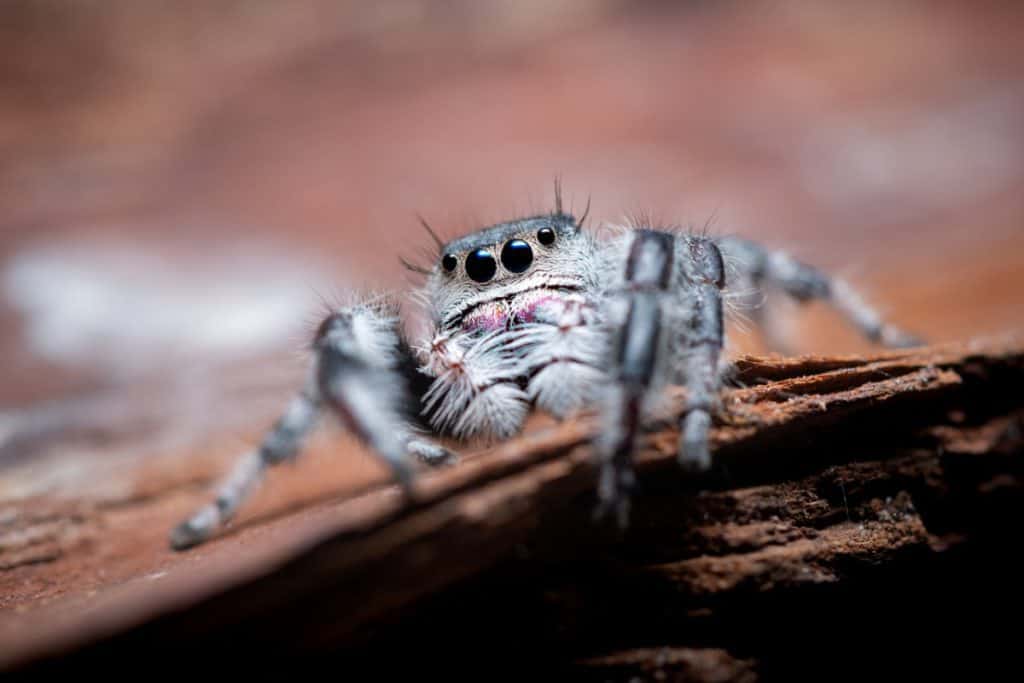
Grey is also a common color in spiders. They can come in many shades of grey, ranging from greyish-brown or black, grey-white to silvery white.
a) Are Grey Spiders Rare?
The Common Grey House Spider (Parasteatoda tepidariorum), referred to as the American House Spider internationally, is extremely common all over the Western Hemisphere. There are also a number of poisonous spiders that are grey, dirty white or brownish grey in color.
They include the Grey Widow Spider (Latrodectus geometricus), sometimes also called the Brown Widow Spider, found in North America. They carry a similar neurotoxin as the Black Widow but delivers less toxin.
Their bites, while painful are less dangerous to humans. Many species of Wolf Spiders found in North America and Australia, as described before, tend to shade towards grey in color.
b) How Do You Identify Grey Spiders?
Grey/brown Widow Spiders are smaller and paler than Black Widows. Like others in the species, it has an hourglass shaped marking on its abdomen – however, the markings in these species are a vivid orange or yellow.
Unlike its relatives, the Brown Widow Spider has a black and white geometric pattern on the dorsal side of its abdomen. Wolf Spiders can be distinguished by their distinctive eyes laid in three rows, four in the bottom tier, and two each in the middle and upper tier.
c) Where Can They Be Found?
Spiders with various shades of grey, mixed in with brown, black or other colors, are found all over the world.
Can Spiders Be Orange?
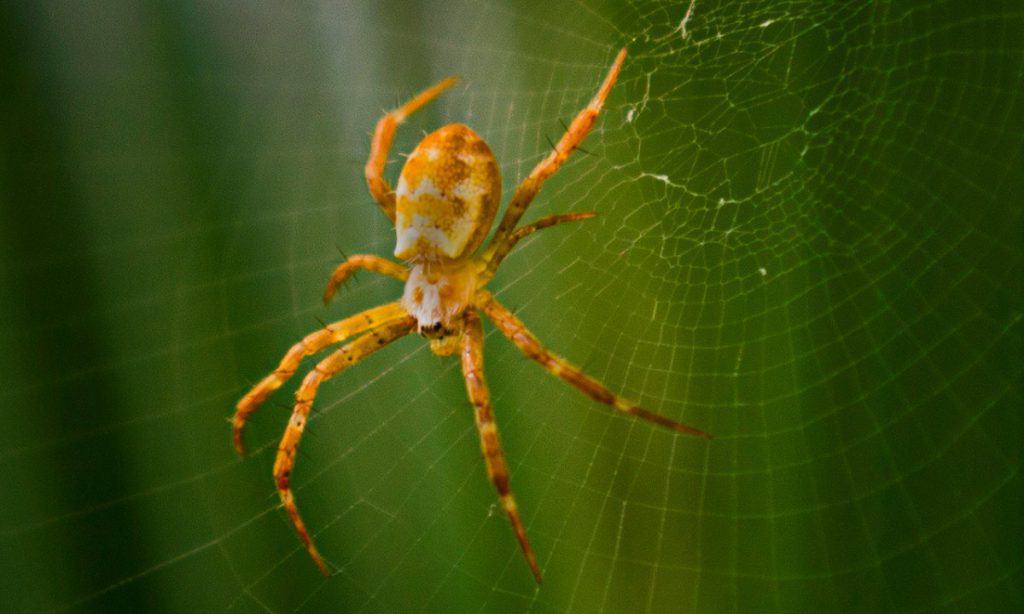
Orange markings are common in spider, though predominantly orange spiders are slightly harder to find. A band of colors, from red to orange to yellow, is found on many spiders.
a) Are Orange Spiders Rare?
Orange spiders, though not as common as brown, black or grey, are not rare. One of the striking examples of a largish orange spider is the Marbled Orb-weaver (Araneus marmoreus), also called the Pumpkin Spider due to the female’s strong resemblance to a pumpkin.
The Four-spot Orb-weaver (Araneus quadratus) vary in appearance from bright orange to green. Another well-known spider is the Orange and Black Tarantula, also known as the Mexican Orange-kneed Tarantula (Euathlus smithii). Females of this species can live as long as 30 years.
b) How Do You Identify Orange Spiders?
Female Pumpkin Spiders are easy to spot given their striking resemblance to pumpkins. The Four-spot Orb-weaver has four characteristic spots on the abdomen. The Orange and Black Tarantula is hairy, possessing black or brown bodies with white markings and prominent orange stripes on their legs and back.
c) Where Can They Be Found?
The Pumpkin Spider lives in North America and Europe, commonly found in gardens. The Four-spot Orb-weaver is common all over Europe and East Asia. The Orange and Black Tarantula is found in North and Central America. Spiders with orange markings can be found all over the world.
Can Spiders Be Red?
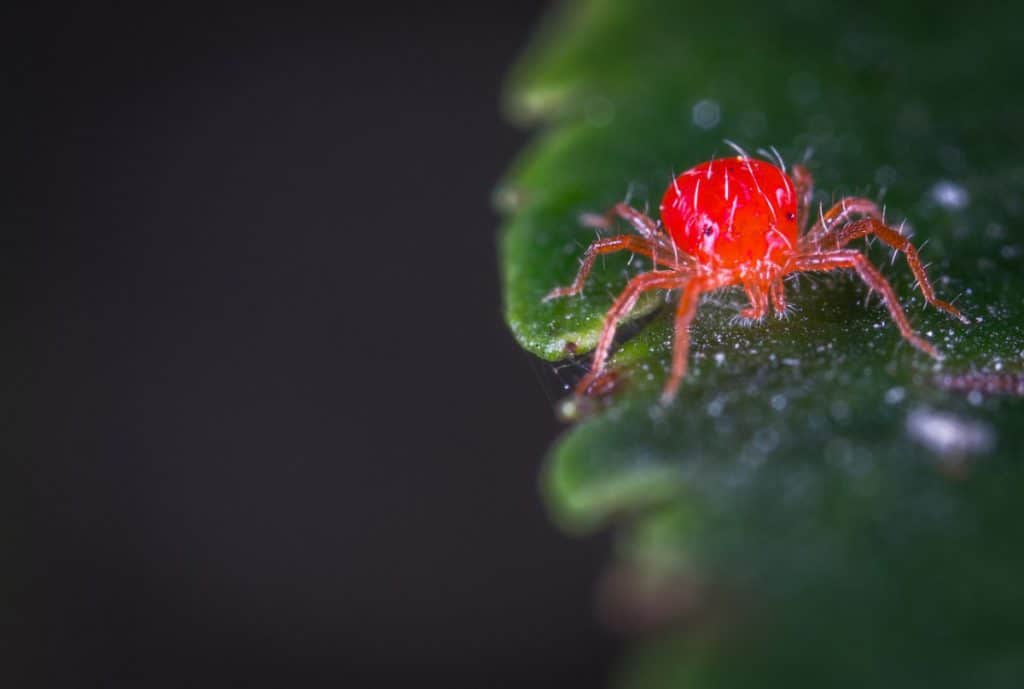
Red is an iridescent color that often exists with black or other bases in spiders.
a) Are Red Spiders Rare?
Red coloration is common in spiders. The Red House Spider (Nesticodes rufipes) is an extremely common species found in North America. Their bite, though painful, is not dangerous. Woodlouse Spiders (Dysdera crocata) have dark red cephalothorax and legs, along with a shiny yellow-brown abdomen.
Other common red spiders include Jumping Spiders with red carapace & abdomen, such as Phidippus apacheanus, Phidippus cardinalis, Phidippus clarus and Phidippus whitmani; as well as ones with red abdominal markings such as Phidippus audax, Phidippus carneuss and Phidippus johnsoni.
Red markings are also common in Ground Sac Spiders (for example, Castianeira descripta) and Orb-weavers (for example, the Spinybacked Orb-weaver (Gasteracantha cancriformis) and the Arrowhead Orb-weaver (Verrucosa arenata)). The Kauai Cave Wolf Spider (Adelocosa anops) is a reddish brown, eyeless cave dweller found in Hawaii.
The most venomous red spider may be the Red Widow Spiders (Latrodectus bishopi). Red Widows are different from their other relatives in the Latrodectus family.
Though their toxin is similar to that delivered by the Black Widow Spider, the Red Widow is rarely known to cause serious harm to human beings, by virtue of the fact that they live in areas away from human habitation.
The Katipo (Latrodectus katipo) or Redback Spiders (Latrodectus hasselti) found in New Zealand are also relatives of the American Black Widow Spiders.
b) How Do You Identify Red Spiders?
In general, the red markings or color make it easy to spot red spiders. The Red House Spider is easy to recognize since its likely to be the only red spider you regularly spot around the house. Red Widows, true to their names, have a red-orange back, with an abdomen that is black with yellow rings and vermillion red legs.
The hourglass markings common among Black and Brown Widows is missing, replaced by several red marks. Black Widow Spiders also have a red hourglass marking on its back.
c) Where Can They Be Found?
Spiders with red markings can be found all over the world. Red Widow Spiders are endemic to central and southern Florida. Katipo and Redback spiders are found in New Zealand.
Can Spiders Be Yellow?
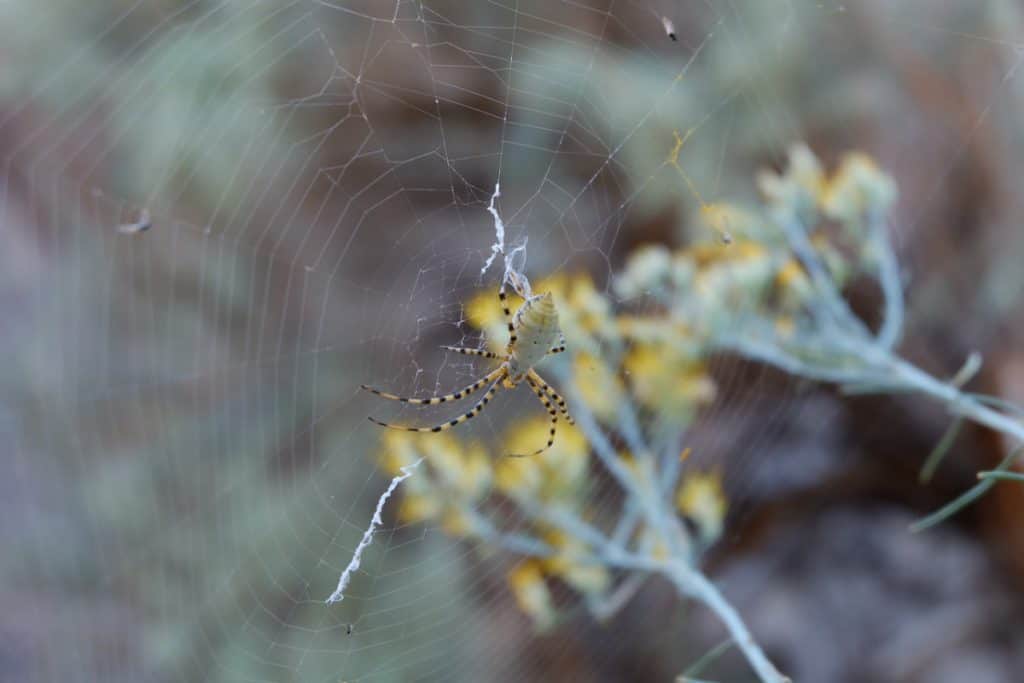
The spiders listed below are predominantly yellow. There are many other species where yellow is combined with some other color on a spider’s body.
a) Are Yellow Spiders Rare?
Yellow or yellowish-green spiders are not rare. One common North American species is the Yellow Sac Spider (Cheiracanthium inclusum or mildei), which are responsible for the majority of spider bites that are found to occur in the US.
Another species, the Yellow Garden Spider (Argiope aurantia), also known as the Golden Garden Spider, Zigzag Spider, Corn Spider or McKinley Spider, is very common in North and Central America. The Goldenrod Crab Spider (Misumena vatia) is adept at camouflage, it may change its color from bright gold to green over the course of a few days as it waits on goldenrod flowers for prey.
The Wasp Spider (Agriope bruennichi) is a species of orb-spider with striking yellow and black markings on its abdomen found all over Europe, Asia and Africa. The Scorpion-Tailed Spider (Arachnura higginsi) is a common yellow spider found in the US.
b) How Do You Identify Yellow Spiders?
Yellow Sac Spiders can be spotted by their colors, which range from pale yellow to green, pink or tan, with black chelicera. Yellow Garden Spiders can be hard to spot if they blend into their surroundings, they have yellow bands on a grayish-black body.
The Wasp Spider has striking markings on its abdomen. The Scorpion-tailed Spider has a distinctive tail like that of a scorpion.
c) Where Can They Be Found?
Yellow spiders are found all over the world.
Can Spiders Be Green?
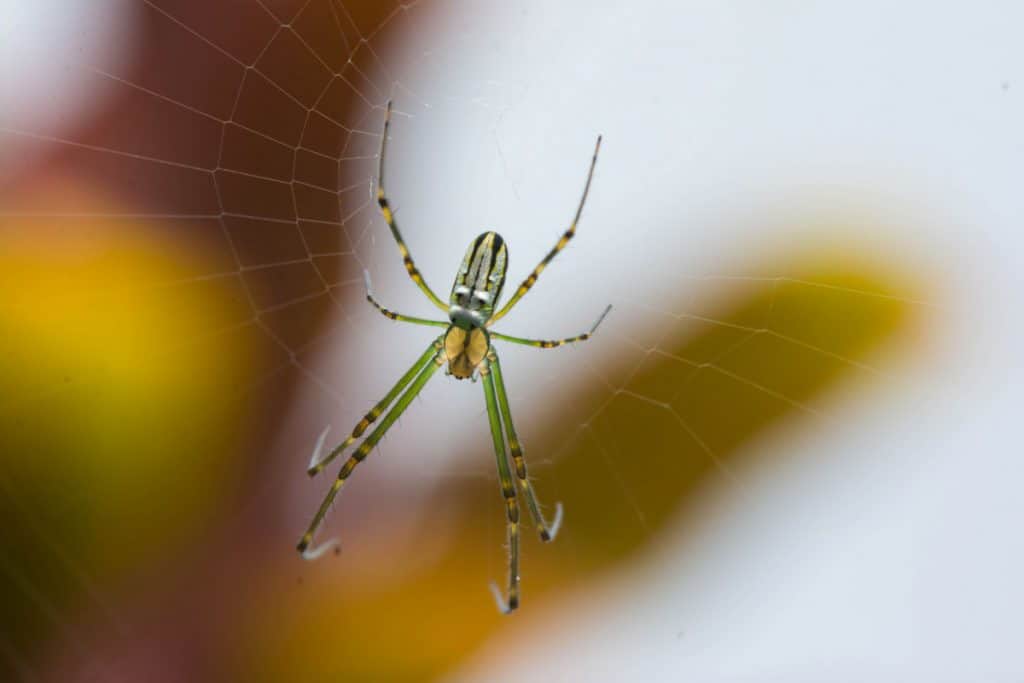
Green spiders have evolved their iridescent colorings to help them blend in among plants and trees. The varieties mentioned below are predominantly green – there are many others with bluish-green or yellow-green shades.
a) Are Green Spiders Rare?
Green spiders are very common in outdoor settings, among plants and shurbbery. The Green Lynx Spider (Peucetia viridans) is usually found on green plants. The Green Orb-weaver (Araniella cucurbitina), also called the “Cucumber Green Spider”, has a strikingly green abdomen.
Araneus guttulatus is another variation of orb-weavers that is green in color, blending in with plants, as do the Red-spotted Orb-weavers (Araneus cingulatus).
b) How Do You Identify Green Spiders?
Natural camouflage could make it hard to spot green spiders in their normal settings. The Green Lynx Spider has a red patch between the eyes, and red marks elsewhere on the body.
They can change color to pale yellow late in the summer. Green Orb-weavers have a bright green abdomen and a reddish-brown head. Red-spotted Orb-weavers have a distinct whitish green body speckled with red dots.
c) Where Can They Be Found?
Green spiders are common all over the world. The Green Lynx Spider is native to North America and parts of the Caribbean. Green Orb-weavers are found all over the UK and parts of Northern Europe.
Can Spiders Be Purple?
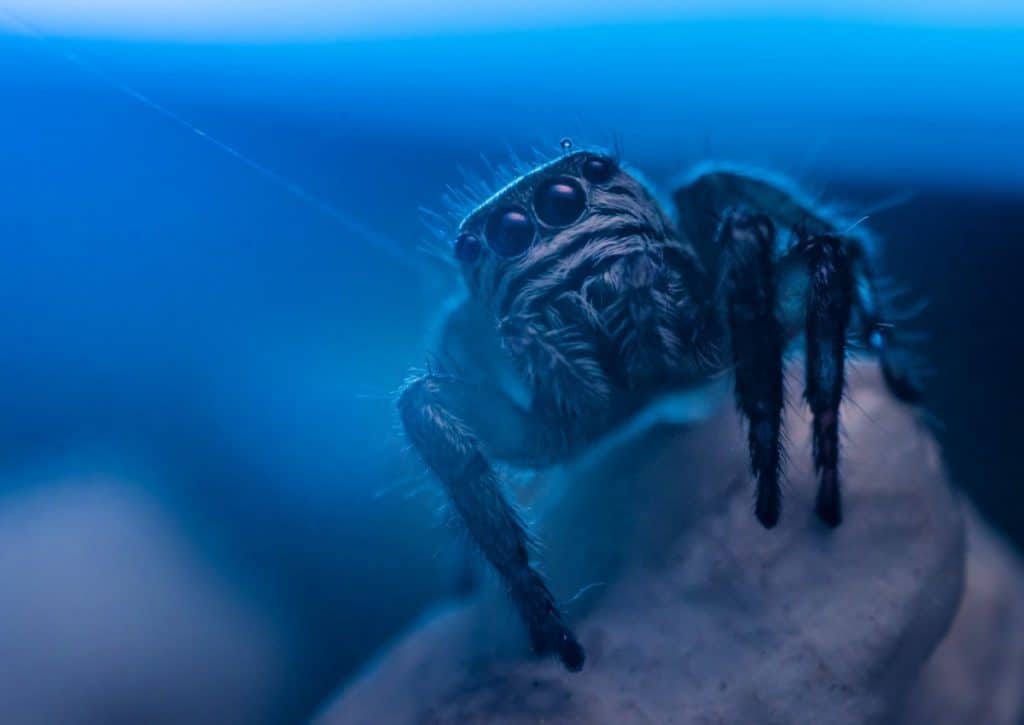
Purple colors in spiders are often caused by iridescence. The coloration is sometimes found in conjunction with other prominent colors, such as pink toes.
a) Are Purple Spiders Rare?
Purple spiders are only found in limited habitats. One of the best-known is the Ecuadorian Purple Pinktoe (Avicularia purpurea), also called the Purple Tree Tarantula. A small (2 inches in size) spider with intense purple-blue iridescence on its body and appendages, it is mainly found in agricultural areas adjacent to the Amazon Basin.
Another tiny species (less than ¼ inches in size), the royal purple and gold Jumping Spiders (Simaetha sp.) was recently discovered in the Sraburi Province of Thailand – it has already become popular as a pet. The male Brazilian Pink Bloom Tarantula (Pamphobeteus platyomma) also shows brilliant pink or purple colors.
There are some species of European Tarantulas that occasionally flash purple coloration.
b) How Do You Identify Purple Spiders?
Dark or bluish-purple colored spiders can be difficult to spot in dim light but are more prominent in bright sunshine. Like most purple spiders, the Purple Tarantula is not venomous, and therefore not harmful for humans.
c) Where Can They Be Found?
The Purple Tree Tarantula is found in Ecuador, the Simaetha sp. Jumping Spider in Thailand and the Brazilian Pinkbloom Spider in Brazil.
Can Spiders Be Blue?
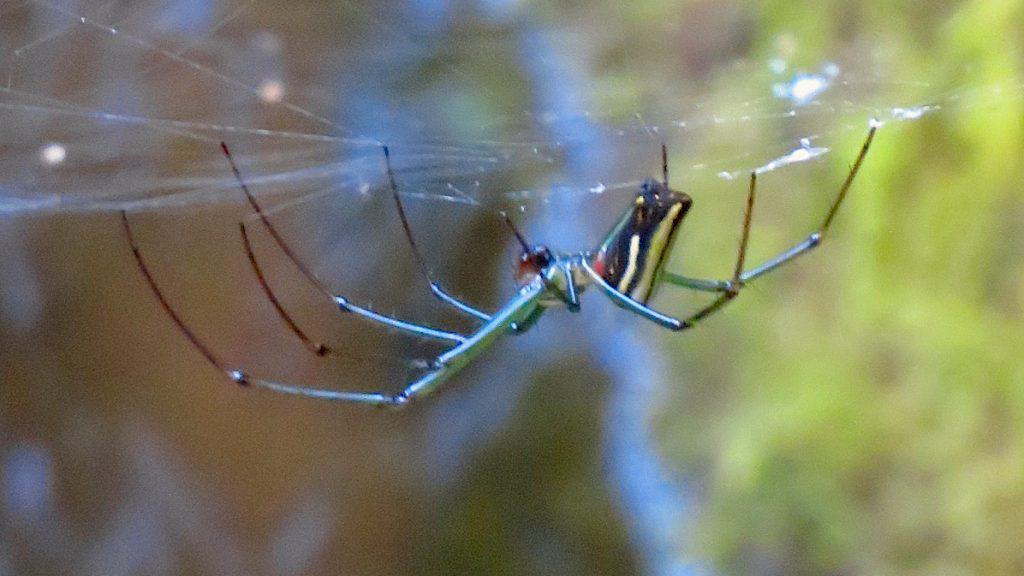
Blue coloration in spiders is principally due to iridescence. Many types of Tarantualas show vibrant, shimmering blue colors that emerge under the right light. Scientists believe that the blue colors evolved for a specific reason, though they are unable to pinpoint what those may be.
Blue tarantulas have poor eyesight, so it’s unlikely that their coloration helps them get spotted by potential mates. Blue spiders have become popular as pets due to their colors.
a) Are Blue Spiders Rare?
Though rare, given that they live in rainforests or rapidly shrinking habitats, some of the more famous blue spiders include the Cobalt Blue Tarantula (Haplopelma lividum), which is indigent to the rainforests of South East Asia.
The Singapore Blue (Lampropelma violaceopes) is a large, aggressive tree dweller with eight dark blue legs around a golden body. Another species, the Gooty Sapphire Ornamental (Poecilotheria metallica), is covered in intricate geometric blue pattern – this species, found in South Eastern India, is considered critically endangered. The Sazima’s Tarantula (Pterinopelma sazimai) has dark blue markings from head to toe.
There are a number of spiders with blue markings, including the Hawaiian Happy Face Spider (Theridion gallatar) and the Australian Red-Headed Mouse Spider (Missulena occatoria). The American Daring Jumping Spider (Phidippus audux) has iridescent blue or green chelicerae.
b) How Do You Identify Blue Spider Species?
Blue spiders often appearing black from a distance, making them difficult to spot. But most of the time, they stand out in the right light. Tarantulas can be spotted due to their very hairy legs and bodies. The brilliant blue color should not entice you, the species mentioned above can cause acute discomfort with their venomous attacks.
c) Where Can They Be Found?
The Cobalt Blue Spider is found in Vietnam, Malaysia, Laos, Myanmar, Singapore, Thailand and Cambodia. The Gooty Sapphire Ornamental is only found in India. The Sazima’s Tarantula is native to Brazil. Spiders with some blue markings can be found in Australia and the US.
Can Spiders Be Pink?
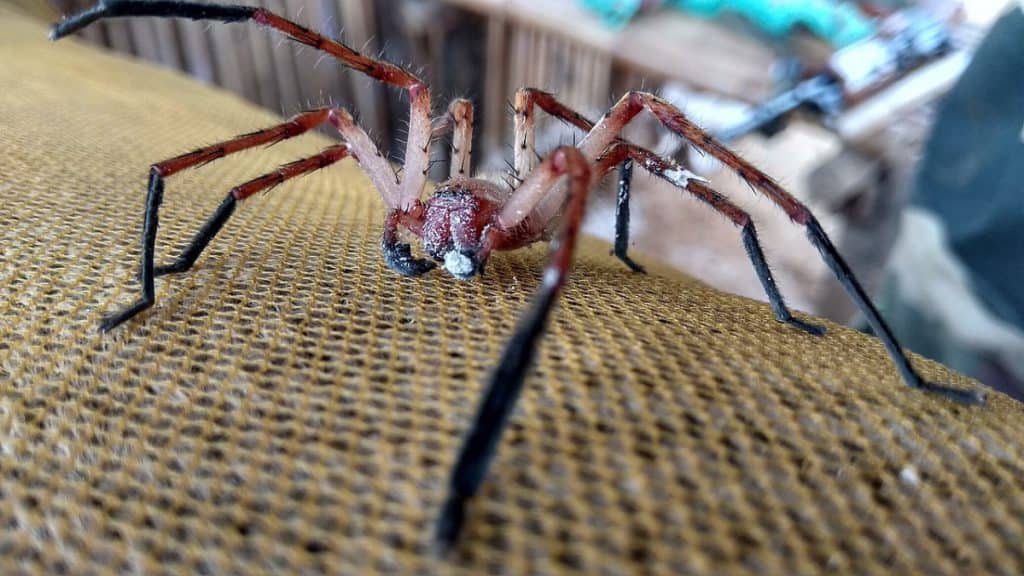
Pink is not a wavelength or particle, and the color does not appear in the visible spectrum. Often times, our brain perceives something to be pink, without the color actually being present. With the exception of flamingoes, the color pink is hard to find among animals.
Spiders are an exception – there are a number of reddish-brown, magenta or similarly colored spiders that do appear distinctly pink in the right settings.
a) Are Pink Spiders Rare?
Though less common than some other colors, a few species of pink spiders exist. Crab spiders that hide on flowers are usually white or yellow, but they can turn pink for camouflage. The Chile Rose tarantulas (Grammostola rosea and Grammostola porteri) are dusty pink to reddish in color.
The male Brazilian Pink Bloom Tarantula (Pamphobeteus platyomma) shows brilliant pink or purple colors. The Brazilian Salmon Pink Birdeater (Lasiodora parahybana) even injects pinkish venom. Additionally, there are several spiders with pink leg or toe markings on a darker body, including the Mexican Pink Leg Tarantula (Brachypelma claasi), the Peruvian Pink Toed Tarantula (Avicularia versicolor) and the Martinique Pink Toed Tarantula (Caribena versicolor).
b) How Do You Identify Pink Spider Species?
Pink spiders are distinctive due to their color and stand out from some of the drab or naturally colored varieties. Some of them may be hard to spot, such as Crab Spiders which hide on pink flowers while waiting for their prey.
c) Where Can They Be Found?
The pink spider species mentioned above are found in Mexico, South America and the Caribbean regions.
In Conclusion …
Spiders are everywhere. While exotic species live outdoors, from gardens to rain forests and sand dunes, there are thousands of species that live very close to humans. They often prefer crawl spaces, attics and basements. Most of them are harmless, but several venomous species are common the world over.
It’s important to be on the look-out for telltale markings, and if bitten, get medical help as symptoms appear. Luckily, antivenins are readily available for spider bites – so a little care will go a long way to avert serious tragedy.
If you enjoyed reading this article, then please share it out on social media. It helps promote the site and keeps me motivated to produce the best articles I can.
All the best
Steve
ps If you’re interested in reading more about the color of insects, why not check out our Color Of Ladybugs article or Color Of Butterflies articles
Recent Posts
Tiny Black Bugs in Bathroom NO WINGS: What They Are and What to Do!
Finding tiny black bugs in your bathroom can be uncomfortable, to say the least. Especially if they are persistent, or they appear in very large numbers, which they often like to do. When it...
Tiny Black Bugs in Plant Soil - What Are They & What To Do About It
A short horror story: You get a new houseplant. You do your best to take care of it. You’ve ensured that it has the right soil, the right amount of sun, it gets enough water. And then one day, you...

